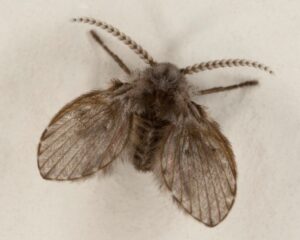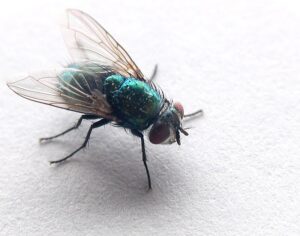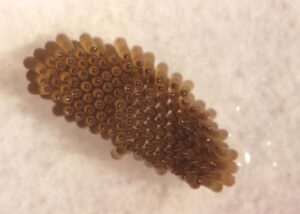Drain Fly, Moth Fly, Sewage Fly, or Filter Fly:
General Description
|

Credit: Sanjay Acharya, bugguide.net |
- Adults have long drooping antennae.
- The larva is slender, white to creamy brown with a distinct head, well-developed mouthparts, and a visible
- The body of the larva has 11 segments, with the last two containing paired breathing
- The pupa is yellow to brown, with two respiratory horns protruding from its
Life Cycle and Common Characteristics
- The female lays up to 100 eggs, and irregular masses of 15 to 40 eggs are most
- Females lay eggs in wet or moist soil, on sides of drains, on decaying organic matter, such as sewage plants, filthy dumpsters, water traps in plumbing fixtures, and garbage disposal units, and almost anywhere decomposing organic materials are found.
- The female does not lay eggs on dry surfaces.
- Eggs will hatch in less than two
- The life stages last around 9 to 15
- Dormancy occurs most frequently during the larval stage, but can also occur during the egg and pupal
- Pupae require 1-2 days before emerging as an
- Males emerge before females and live only a few
- Females that have not laid eggs can live up to seven
- Drain flies complete their life cycle in 3 to 4 weeks. Under favorable circumstances, the flies can go through one generation in as little as one week.
- Drain flies are usually seen swarming around and resting on the walls of bathrooms, building exteriors, and showers near suitable larval
- The source of the fly infestation is generally from sinks and floor drains, on walls near plumbing fixtures, on the sides of tubs and showers, from nearby sewage plants, or waste disposal Polluted waters and wet organic materials are preferred breeding areas of the fly.
- Flies occurrence is associated with standing water which can develop in any area with standing water with organic
- The larvae can be found feeding on the film of wet organic material that can accumulate in
Damages and Medical Implications
- Drain fly is an annoying and troublesome pest that concerns numerous
- In homes, adults are found on the walls of the bathroom, kitchen, or basement.
These flies are non-biting and are not capable of transmitting any known pathogens, and are of little economic importance. - Drain flies that breed in sewage do not transmit human disease.
- Large fly infestations can cause respiratory problems due to the possibility of inhaling fine hair-like scales that can fall off their bodies .




